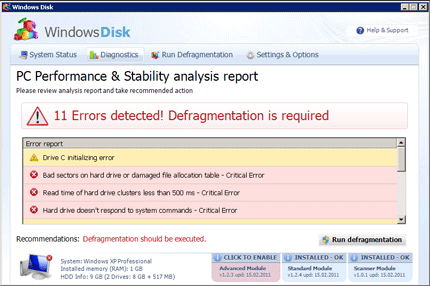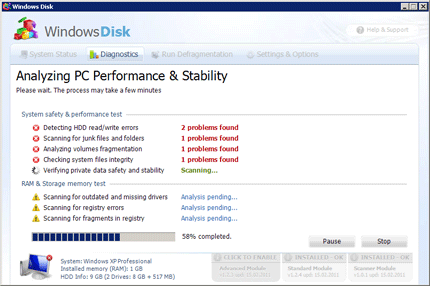TROJ_FAKEAV.CAC
Trojan.Win32.Agent.hhvq (Kaspersky)
Windows 2000, Windows XP, Windows Server 2003


Threat Type: Trojan
Destructiveness: No
Encrypted: No
In the wild: Yes
OVERVIEW
It drops component files that Trend Micro also detects as TROJ_FAKEAV.CAC.
This Trojan may be downloaded by other malware/grayware/spyware from remote sites. It may be unknowingly downloaded by a user while visiting malicious websites.
It executes then deletes itself afterward.
It displays fake alerts that warn users of infection. It also displays fake scanning results of the affected system. It then asks for users to purchase it once scanning is completed. If users decide to purchase the rogue product, users are directed to a certain website asking for sensitive information, such as credit card numbers.
TECHNICAL DETAILS
Varies
PE
Yes
01 Feb 2011
Displays message/message boxes
Arrival Details
This Trojan may be downloaded by other malware/grayware/spyware from remote sites.
It may be unknowingly downloaded by a user while visiting malicious websites.
Installation
This Trojan drops the following component file(s):
- %Application Data%\{random file name}.exe - also detected as TROJ_FAKEAV.CAC
- %Application Data%\mbnYpfcsksFIKuQ.dll - also detected as TROJ_FAKEAV.CAC
(Note: %Application Data% is the current user's Application Data folder, which is usually C:\Windows\Profiles\{user name}\Application Data on Windows 98 and ME, C:\WINNT\Profiles\{user name}\Application Data on Windows NT, and C:\Documents and Settings\{user name}\Local Settings\Application Data on Windows 2000, XP, and Server 2003.)
It drops the following copies of itself into the affected system:
- %Application Data%\irRCpVinxLWrQQS.exe
(Note: %Application Data% is the current user's Application Data folder, which is usually C:\Windows\Profiles\{user name}\Application Data on Windows 98 and ME, C:\WINNT\Profiles\{user name}\Application Data on Windows NT, and C:\Documents and Settings\{user name}\Local Settings\Application Data on Windows 2000, XP, and Server 2003.)
It executes then deletes itself afterward.
It displays the following fake error messages:
A hard drive error occured while starting the application.
Autostart Technique
This Trojan adds the following registry entries to enable its automatic execution at every system startup:
HKEY_CURRENT_USER\Software\Microsoft\
Windows\CurrentVersion\Run
irRCpVinxLWrQQS.exe = "%Application Data%\irRCpVinxLWrQQS.exe"
Other System Modifications
This Trojan adds the following registry entries as part of its installation routine:
HKEY_CURRENT_USER\Software
12B79064-EB17-4f82-9DFE-B975BD26D1DC =
HKEY_CURRENT_USER\Software\Microsoft\
Windows\CurrentVersion\Policies\
Associations
LowRiskFileTypes = "/{hq:/s`s:/ogn:/uyu:/dyd:/c`u:/bnl:/ble:/sdf:/lrh:/iul:/iulm:/fhg:/clq:/kqf:/`wh:/lqf:/lqdf:/lnw:/lq2:/l2t:/v`w:/rbs:"
HKEY_CURRENT_USER\Software\Microsoft\
Windows\CurrentVersion\Policies\
Attachments
SaveZoneInformation = 1
It modifies the following registry key(s)/entry(ies) as part of its installation routine:
HKEY_CURRENT_USER\Software\Microsoft\
Internet Explorer\Download
CheckExeSignatures = "no"
(Note: The default value data of the said registry entry is "yes".)
Rogue Antivirus Routine
This Trojan displays the following fake alerts:
It displays fake alerts that warn users of infection. It also displays fake scanning results of the affected system. It then asks for users to purchase it once scanning is completed. If users decide to purchase the rogue product, users are directed to a certain website asking for sensitive information, such as credit card numbers.
SOLUTION
8.900
7.804.18
01 Feb 2011
Step 1
For Windows XP and Windows Server 2003 users, before doing any scans, please make sure you disable System Restore to allow full scanning of your computer.
Step 2
Restart in Safe Mode
Step 3
Delete this registry value
Important: Editing the Windows Registry incorrectly can lead to irreversible system malfunction. Please do this step only if you know how or you can ask assistance from your system administrator. Else, check this Microsoft article first before modifying your computer's registry.
- In HKEY_CURRENT_USER\Software\Microsoft\Windows\CurrentVersion\Run
- irRCpVinxLWrQQS.exe = %Application Data%\irRCpVinxLWrQQS.exe
- irRCpVinxLWrQQS.exe = %Application Data%\irRCpVinxLWrQQS.exe
- In HKEY_CURRENT_USER\Software\Microsoft\Windows\CurrentVersion\Policies\Attachments
- SaveZoneInformation = 1
- SaveZoneInformation = 1
- In HKEY_CURRENT_USER\Software
- 12B79064-EB17-4f82-9DFE-B975BD26D1DC
- 12B79064-EB17-4f82-9DFE-B975BD26D1DC
- In HKEY_CURRENT_USER\Software\Microsoft
- BootData = %Application Data%\{Random File Name}.exe
- BootData = %Application Data%\{Random File Name}.exe
- In HKEY_CURRENT_USER\Software\Microsoft\Windows\CurrentVersion\Policies\Associations
- LowRiskFileTypes = /{hq:/s`s:/ogn:/uyu:/dyd:/c`u:/bnl:/ble:/sdf:/lrh:/iul:/iulm:/fhg:/clq:/kqf:/`wh:/lqf:/lqdf:/lnw:/lq2:/l2t:/v`w:/rbs:
Step 4
Restore this modified registry value
Important: Editing the Windows Registry incorrectly can lead to irreversible system malfunction. Please do this step only if you know how or you can ask assistance from your system administrator. Else, check this Microsoft article first before modifying your computer's registry.
- In HKEY_CURRENT_USER\Software\Microsoft\Internet Explorer\Download
- From: CheckExeSignatures = no
To: yes
- From: CheckExeSignatures = no
Step 5
Restart in normal mode and scan your computer with your Trend Micro product for files detected as TROJ_FAKEAV.CAC. If the detected files have already been cleaned, deleted, or quarantined by your Trend Micro product, no further step is required. You may opt to simply delete the quarantined files. Please check this Knowledge Base page for more information.
Step 6
Scan your computer with your Trend Micro product to delete files detected as TROJ_FAKEAV.CAC. If the detected files have already been cleaned, deleted, or quarantined by your Trend Micro product, no further step is required. You may opt to simply delete the quarantined files. Please check this Knowledge Base page for more information.
Did this description help? Tell us how we did.



